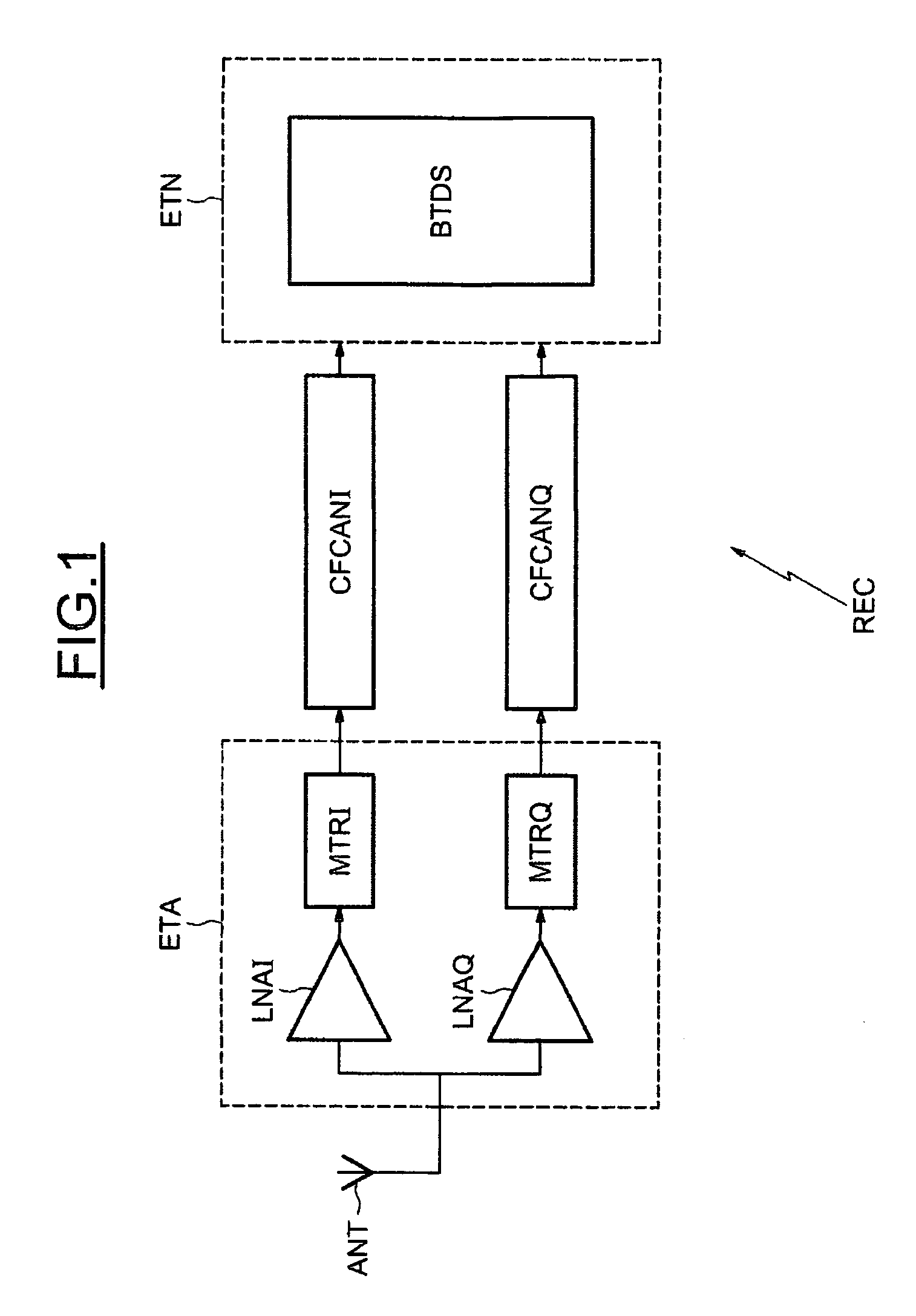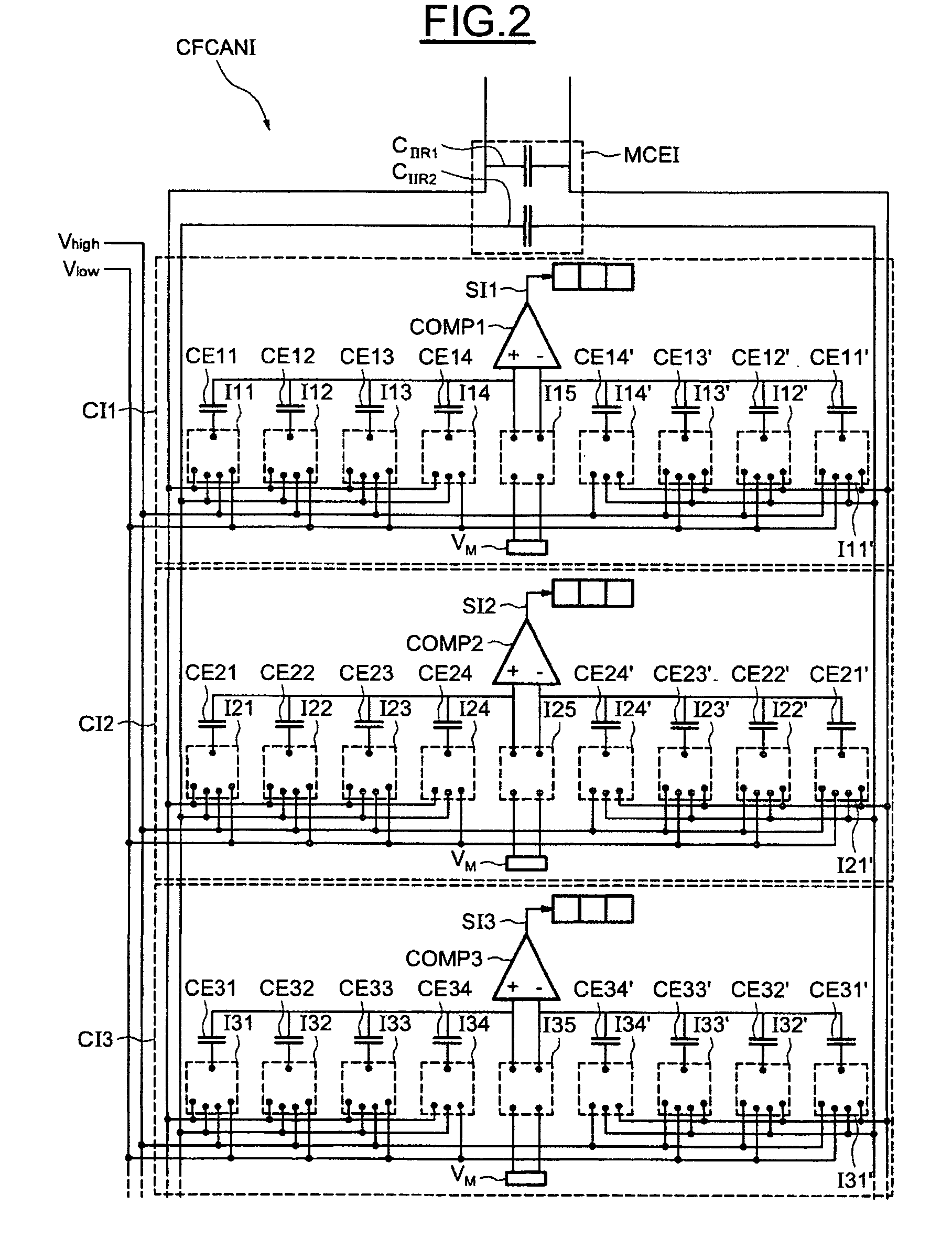Method and device for processing an incident signal, in particular for filtering and analog/digital conversion
a technology of incident signals and filtering, applied in the direction of code conversion, pulse techniques, instruments, etc., can solve the problems of not being able to follow the same evolution of external elements of the analog part of the signal processing, and not being able to fabricate analog and digital parts, so as to achieve the effect of easy calculation
- Summary
- Abstract
- Description
- Claims
- Application Information
AI Technical Summary
Benefits of technology
Problems solved by technology
Method used
Image
Examples
first embodiment
[0158]FIG. 2 shows the filtering and analog / digital conversion circuit CFCANI, using differential architecture. It goes without saying that this embodiment is not limited to a differential architecture, and those skilled in the art will readily be able to adapt the description that follows to a non-differential architecture.
[0159]In this embodiment, the circuit CFCANI comprises input capacitance means MCEI comprising two filtering capacitors CIIR1 and CIIR2. The filtering capacitors CIIR1 and CIIR2 are capacitors referred to as ‘memory capacitors’ whose capacitance is high and is not reset to zero. It also comprises elementary circuits allowing, on the one hand, the intermediate signal to be filtered with the input capacitance means MCEI and, on the other, the filtered intermediate signal to be converted by successive approximations in such a manner as to deliver samples with N bits of a digital output signal. In view of the number (2) of filtering capacitors and of the fact that th...
second embodiment
[0200]This is because by introducing a signal of known frequency and amplitude into the circuit CAFCANI′, it is possible to deduce therefrom the transfer function G1 of the low-pass filtering at the frequency of the signal. In particular, in the case of the second embodiment, it is possible to introduce such a signal only by modifying the switching states of the switches during the reference state, without introducing an intermediate signal at the current input. An example of a method of determining the transfer function G1 of the low-pass filtering at a given frequency is described below.
[0201]FIG. 12 shows the first configuration state of the circuit CAFCANI′ during the method of determining the transfer function G1 of the low-pass filtering at a given frequency. In this first state, the first elementary circuit CI1′ is placed in a reference state different from that of the conventional operation described previously. This is because all the switches of the first elementary circui...
third embodiment
[0283]In a third embodiment, the case is considered in which the filter FRFI is also run at a working frequency FS / Ndiv different from the sampling frequency FS of the analog / digital converter CANI, and the filter FPBAI is a low-pass filter of order 1 and of cutoff frequency f0. As previously, the transfer function of the reformatting filter FRFI is an approximation Happrox of the inverse H of the transfer function of the filter FPBAI. It will also be considered that the filter FRFI is of the finite-impulse-response type of order Nfir=2N−1. The transfer function Happrox of the filter FRFI can be written in the form:
[0284]Happrox=1+∑n=1n=N-1αn(zn-z-n)withz-n=ⅇ2ⅈπnfNdivFs
[0285]which corresponds, with a shift of z−N+3, to
[0286]∑m=0m=Nfir-1αm1z-m.
[0287]The determination of the approximate transfer function Happrox comprises the determination of the coefficients [α1; . . . ; αN−1]. When the filter FPBAI is of order 1, the coefficients [α1; . . . ; αN−1] may be calculated dir...
PUM
 Login to View More
Login to View More Abstract
Description
Claims
Application Information
 Login to View More
Login to View More - R&D
- Intellectual Property
- Life Sciences
- Materials
- Tech Scout
- Unparalleled Data Quality
- Higher Quality Content
- 60% Fewer Hallucinations
Browse by: Latest US Patents, China's latest patents, Technical Efficacy Thesaurus, Application Domain, Technology Topic, Popular Technical Reports.
© 2025 PatSnap. All rights reserved.Legal|Privacy policy|Modern Slavery Act Transparency Statement|Sitemap|About US| Contact US: help@patsnap.com



